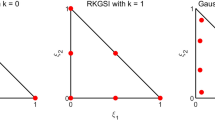Abstract
This study investigates the application of marching scheme and mollification method to solve a one-dimensional inverse ablation-type moving boundary problem. The problem is considered with noisy data. A regularization method based on a marching scheme and discrete mollification approach is developed to solve the proposed problem and the stability and convergence of the numerical solution are proved. Some numerical experiments are presented to demonstrate the attractiveness and feasibility of the proposed approach. It is shown that the results are in good agreement with exact solutions.




Similar content being viewed by others
References
Acosta CD, Meja CE (2008) Stabilization of explicit methods for convection diffusion equations by discrete mollification. Comput Math Appl 55:368–380
Acosta CD, Meja CE (2009) Approximate solution of hyperbolic conservation laws by discrete mollification. Appl Numer Math 59:2256–2265
Andrews G, Atthey DR (1975) On the motion of an intensely heated evaporating boundary. J Inst Math Appl 15:59–72
Ang DD, Dinh APN, Tranh D (1996) An inverse Stefan problem: identification of boundary value. J Comput Appl Math 66:75–84
Ang DD, Dinh APN, Tranh D (1996) An inverse Stefan problem. J Comput Appl Math 66:75–84
Campbell AJ, Humayun M (1999) Trace element microanalysis in iron meteorites by laser ablation, ICPMS. Anal Chem 71(5):939–946
Carslaw HS, Jaeger JC (1959) Conduction of heat in solids, 2nd edn. Clarendon Press, Oxford
Garshasbi M, Reihani P, Dastour H (2012) A stable numerical solution of a class of semi-linear Cauchy problems. J Adv Res Dyn Cont Syst 4:56–67
Grzymkowski R, Slota D (2006) One-phase inverse Stefan problem solved by Adomain decomposition method. Comput Math Appl 51:33–40
Johansson BT, Lesnic D, Reeve T (2011) A method of fundamental solutions for the one-dimensional inverse Stefan problem. Appl Math Model 35:4367–4378
Kwag DS, Park IS, Kim WS (2004) Inverse geometry of estimating the phase front motion of ice in a thermal storage system. Inv Prob Sci Eng 12:743–756
Meja CE, Murio DA, Zhan S (2001) Some applications of the mollification method. In: Lassonde M (ed) Appr., optim. math. econ. Physica-Verlag, pp 213–222
Minkowycz WJ, Sparrow EM, Murthy JY (2009) Handbook of numerical heat transfer, 2nd edn. Wiley, New York
Mitchell SL, Vynnycky M (2012) An accurate finite-difference method for ablation-type Stefan problems. J Comput Appl Math 236:4181–4192
Molavi H, Hakkaki-Fard A, Molavi M, Rahmani RK, Ayasoufi A, Noori S (2011) Estimation of boundary conditions in the presence of unknown moving boundary caused by ablation. Int J Heat Mass Trans 54:1030–1038
Murio DA (2002) Mollification and space marching. In: Woodbury K (ed) Inverse engineering handbook. CRC Press, USA
Murio DA (1993) The mollification method and the numerical solution of ill-posed problems. Wiley-Interscience, New York
Murio DA (2007) Stable numerical solution of a fractional-diffusion inverse heat conduction problem. Comput Math Appl 53:1492–1501
Storti M (1995) Numerical modeling of ablation phenomena as two-phase Stefan problems. Int J Heat Mass Trans 38:2843–2854
Acknowledgments
The authors would like to thank the anonymous referees for their valuable comments and suggestions which substantially improved the manuscript.
Author information
Authors and Affiliations
Corresponding author
Additional information
Communicated by Domingo Alberto Tarzia.
Rights and permissions
About this article
Cite this article
Garshasbi, M., Dastour, H. A mollified marching solution of an inverse ablation-type moving boundary problem. Comp. Appl. Math. 35, 61–73 (2016). https://doi.org/10.1007/s40314-014-0180-5
Received:
Revised:
Accepted:
Published:
Issue Date:
DOI: https://doi.org/10.1007/s40314-014-0180-5




